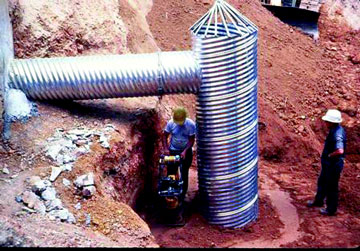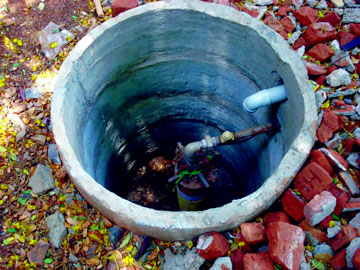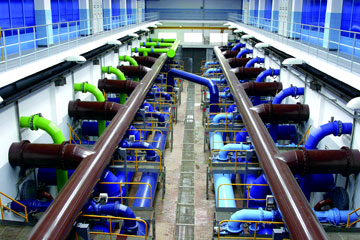Water Oriented Development
A.K. Jain
One of the basic concerns of planning and design is to provide efficient and sustainable access to water. In view of the dwindling water resources and its quality and also to meet the objectives of 'water for all and always', the concept of Water Oriented Development (WOD) is emerging as a basic prerequisite of planning, design and engineering.
Indiscriminate urbanization by the industries, sanitary landfill sites, power stations, housing, unauthorized colonies, slums, etc. along the wetlands, water bodies and rivers have adversely affected the quantity and quality of water and significantly altered the hydrology. Many water bodies in urban areas have vanished due to incompatible land uses and encroachments. It is necessary that the land use pattern is carefully worked out so as not to precipitate such a situation. It is equally essential to provide proper sanitation, sewerage and solid waste disposal system to avoid the pollution of water. It is a paradox that while on one hand we face the water crisis, on the other there is flooding during the monsoons. This is largely due to lack of water oriented planning and design. Excessive hard paving of open areas, disturbing the natural contour and flow of drainage, building of structures and roads in the natural depressions, silting of drains, water bodies and rivers, disposal of high amount of solid waste in water bodies, etc. are responsible for an impending water crisis.
 |
Planning and design strategies need to consider a detailed analysis of hydrology, topography, aquifers, rainfall, flooding, drainage, vegetation cover and water harvesting potential, with site specific environmental considerations, local skills and traditional cultural and community practices.
The starting point of planning is the convergence of blue and green networks. It means identifying the natural drainage, water channels, canals, flood zones, etc. and protect them by green portals. It involves arresting the run-off and conservation of natural valleys, water bodies and aquifers. The natural drainage system should be meticulously studied for allowing maximum ground water recharge and rainwater harvesting in the natural or man-made catchment areas. The retention ponds, sediment traps and balancing lakes can be developed for storage of the surplus rainwater during the monsoons rather than allowing it to flood the downstream areas. Watershed management should ensure the conservation of natural valleys, water bodies and aquifers. This needs segregating wastewater disposal from storm drainage. Green networks enveloping the surface water bodies protect the ecology, as well as provide a pleasant environment. Simple methods of site planning, which incorporate porous/semi permeable paving, drop inlet/down pipe, sediment trap, storm sewer, retention ponds, etc. contribute in maintaining ground water table. In order to maintain the equilibrium between the natural eco-system, water and human activities, decentralised planning and community participation is the backbone of water oriented development. The basic principles of Water Oriented Development (WOD) is to confine urban development to the uplands, and protect the wet-lands, streams and water bodies by leaving adequate fringes of vegetation and giving them community ownership, sacred or legal shield. It aims to preserve and utilise the natural drain ways and maximise conservation of water by various methods, such as, underground rainwater storage, contour trenching, pits, deep holes and wells, step wells, tanks, baolis, ponds and balancing lakes. Porous paving on service roads, footpaths and parking areas over a bed of pebbles and coarse sand allows water percolation. To save underground water from pollution soak pits, septic tanks and landfills must be located at a safe distance (say 20 to 30 m). On-channel storage helps in groundwater recharge.
The quality of river water should be protected by securing a continuous flow, aquatic life and installation of water purification facilities. This needs a comprehensive and interlinked plan of water sources, drainage, waste water treatment and sewage. This needs strict pollution control measures and eco-sensitive land use controls. Water flows need to be controlled at the riverbank and marked at each kilometre station. The valleys should be zoned for greenery and forests, so that an attractive water portal can be created in urban areas.
 |
Mandatory performance bonds and liability insurance should pay for all damages plus any corrective measures, which might be needed in case of water pollution by any developer/industry or department. As a rule, no new development, manufacturing, process or operation of any polluting activity should be permitted, which may result in the significant degradation of any water resource. For example, Delhi Master Plan 2021 mandates recovery and landscaping of the old canals and water channels (350 km long) and conservation of 600 odd water bodies as prime areas of water storage and recreation. This would also help in a quicker, efficient and economical drainage, replenishment and enrichment of underground water table, availability of rolling greens and recreational areas, linking the population with the waterfront, improving the micro-climate, and interconnected parkways. Simple, wild and natural landscape of water corridors would be ecologically important rather than elaborate, exotic landscaping.
Water Conservation and Efficiency
 |
The wasteful practice of ‘drill, pump, and spill’ has to be replaced by efficient methods of water conservation, use, and recycling. There is a need to incorporate the mandatory stipulations for water saving tanks, flushing system, gadgets, faucets, showers, pools, fixtures, tanks, etc. in the Building Bye-laws. All large buildings should incorporate the rainwater harvesting, wastewater recycling and dual piping system. While one piping system will feed the primary treated rainwater for washing, water coolers and garden taps, the second for supplying municipal potable water. All buildings having a discharge of over 10,000 litres a day should incorporate wastewater recycling, which can be used for horticulture purpose. For conservation of urban water supply, large public building should have twin or triple water systems; - one for drinking water, which comes from public utility, second for the rainwater, which is supplemented by treated wastewater for washing, gardening and non-drinking purpose. Micro drip irrigation and xeriscaping can be adopted to save water for irrigation and gardening. To discourage mosquito breeding in stagnant water, small fountains and cascades can be provided. Leak detection and rectification works should be assisted by the utilities. Meters should be installed for consumers of municipal water and ground water, and also for waste water discharge.
Recharging of aquifers
Indiscriminate extraction of ground water can be controlled through registering boreholes and charging for water extraction. It can be regulated by measures, such as metering and taxing groundwater and augmenting its recharge through spreading techniques, check dams, percolation tanks, direct injection methods and utilizing the abandoned structures for rainwater harvesting.
Minimise non-revenue water
One of the simplest, but cost and pragmatic way to improve quantity and quality of water supply is to reduce unaccounted flow of water (UFW) and production losses at the treatment plants. About one-third of the water in Indian cities that is treated and distributed at public expense is non-revenue water. This is due to unrecorded usage or illegal taps and water connections. Reducing water losses is cheaper than augmenting water capacity. Major strategies include installing, servicing and recalibrating meters, updating and reviewing consumer records to estimate consumption when meters are unserviceable and streamlining the procedures to assist consumers to take legal connection. With better cost recovery, it is possible to improve the quality and availability of water, even in low-income areas.
Case Study
Delhi Water Supply - Discovering the Unexploited Opportunities
Water stress is a growing problem in Delhi, particularly due to excessive water consumption and population growth. The Master Plan for Delhi-2021 (MPD-2021), which was notified in 2007, gave a close look to the issue of water supply and discovered that there are numerous unexploited opportunities for saving and augmenting water supply. The MPD 2021 emphasises that it is imperative to not only to initiate new projects and upgrade present infrastructure, but also to promote water conservation through an integrated and a community driven model, comprising of complimentary short term and long term measures, as given below:
- Recycling of treated wastewater with separate lines for potable water and recycled water. For this, dual pipe supply system shall be introduced in a phased manner in all the areas.
- Ground water recharging through rain water harvesting, conserving water bodies and controlling groundwater extraction. Groundwater extraction is to be controlled through registering boreholes and recharging according to test yields.
- To prepare and implement mandatory rain water harvesting schemes with the aim of optimizing water use and ground water recharge. For this suitable mandatory provision be made for planning and construction of various schemes.
- Dovetail watershed management and arrest the run-off to ensure the conservation of natural valleys, water bodies and aquifers. The concept of ‘zero run-off drainage’ with retention ponds, sediments traps and balancing lakes should be adopted, with a segregated wastewater disposal system. A green network overlapping the blue network would protect the ecology of aquifers, and also provide a pleasant environment. Simple methods of site planning, which incorporate porous/semi permeable paving, drop inlet/down pipe, sediment trap, retention ponds, etc. will contribute in maintaining ground water table.
- Pollution control of rivers, major drains and canals, with indiscriminate dumping of wastes, have become polluted and foul. These need strict pollution control measures and eco-sensitive land use controls. Water flow needs to be controlled and stabilized and marked at each kilometer station. The valleys should be zoned as water portals, so that these are flanked with greenery, farmlands and forests. Where the hazard of pollution exists, the minimum charge for operating permits should cover the expenses of adequate policing and controls/ mandatory performance bonds and liability insurance.
- To improve the quality of river-water secure its continuous flow and encourage the return of aquatic life. This needs improvement of drainage, waste water treatment and pollution abatement by sewerage improvement. The surplus water during the monsoons should be retained in balancing ponds along the riverbed rather than allowing it to the downstream areas.
- Landscaping of the drains and waterfront can be taken up in the form of interconnected parkways. There is no need for elaborate gardening of the greenways, but wild, simple and natural stretch by itself would be ecologically important. Such trails could be one of the cheapest forms of drainage and recreation. The drainage basins shall be made self-sustainable in water management by integrating water-sewerage-drainage systems.
- Water supply in new areas should incorporate separate lines – one for washing, w.c. flushing, water coolers and garden taps, the second for supplying potable water. All non-residential buildings having a discharge of over 10,000 liters day should incorporate a wastewater recycling.
- Efficient methods of water conservation, use and recycling need to incorporate the mandatory stipulation of water saving appliances and waterless flushing system in the Building Byelaws.
- Controlling leakages and UFW: All measures be taken to reduce unaccounted flow of water (UFW), production losses at existing plants.
About half of the water that is treated and distributed at public expense is non-revenue water. This is due to unrecorded usage or illegal taps and water connections. Reducing water losses is cheaper than augmenting water capacity for such losses.
References
- Delhi Development Authority (2007), Master Plan of Delhi, 2021, New Delhi
- Jain, A.K., (in print), The Idea of Green Building, Khanna Publishers, New Delhi.
- Jain, A.K. (2007), Water – A Manual for Architects, Engineers, and Managers, Daya, N. Delhi.
- Jain A.K,( 2011), Making Infrastructure Work, Discovery Publishers, New Delhi
- efficient and sustainable access to water water for all and always’, sanitation, sewerage and solid waste disposal system to avoid the pollution of water
- The retention ponds, sediment traps and balancing lakes
- protect the wet-lands, streams and water bodies
 |
A.K. Jain as Commissioner (Planning), worked on Master Plan for Delhi-2021, National Urban Housing and Habitat Policy and National Urban Transport Policy. He is author of Water A Manual for Architects, Engineers, and Managers. ak.jain6@gmail.com
|